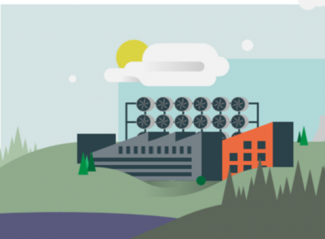NETL is helping establish four new regional direct air capture (DAC) Hubs around the U.S. to demonstrate how the innovative carbon dioxide (CO2) removal technology can be put to work curbing the world’s climate crisis.
With $3.5 billion from the Bipartisan Infrastructure Law (BIL), the U.S. Department of Energy’s (DOE) Office of Fossil Energy and Carbon Management, Office of Clean Energy Demonstrations, and NETL are creating the four regional DAC Hubs to help achieve a net-zero greenhouse gas (GHG) economy by 2050 in a cost-effective, reliable and efficient manner, and to maximize the benefits of the clean energy transition as the nation works to curb the climate crisis, empower workers, and advance environmental justice.
DAC technologies use chemical reactions to pull CO2 directly out of the air independent of point sources. Active air contractors use fans or blowers to move the air through the adsorbing materials while passive contractors use wind to move the air across the adsorbing material. After DAC technologies separate CO2 from ambient air, extracted CO2 in a pure, compressed form, is delivered for underground storage or conversion to valuable products.
The hubs will demonstrate processing, transport, secure geologic storage, and/or conversion of CO2 captured from the atmosphere with DAC technology and accelerate commercialization of those technologies.
Each of the proposed hubs will be able to remove and sequester and/or utilize at least 1,000,000 metric tons of carbon dioxide from the atmosphere annually from a single unit or multiple interconnected units and have the potential to be developed into a regional or interregional carbon network.
Elliot Roth, a Project Manager in NETL’s CO2 Removal and Conversion Team, explained that the goal of the regional DAC Hubs effort is to help start-up a commercial DAC industry and establish the U.S. as a global leader in demonstrating the commercial viability of the critical climate technology.
“There are four specific sub-goals in the initial DAC Hub project,” he said. “First of all, the effort is designed to help validate commercial scale demonstrations of DAC technologies to build confidence leading to private sector capital formation. That step incorporates assessing scale-up risks, cost performance, business models, host sites, infrastructure, markets and financing structures for the most promising technologies and Hub approaches.”
The next sub-goal of the project, according to DOE, is to build out the infrastructure to scale up DAC technologies and concepts, including clean power generation, heat integration, transport, and secure geologic storage and conversion pathways for captured CO2.
Climate impact is another sub-goal objective that will prove, at a commercial scale, that DAC technologies can maximize net-emissions goals and address potential environmental impacts like water availability.
The final sub-goal addresses responsible demonstration of DAC technologies showing how they could provide positive benefits to communities while minimizing negative impacts and making progress toward DOE’s Carbon Negative Shot, which aims to develop less than $100/net metric ton CO2–equivalent removal by 2032.
The initial round of funding makes more than $1.2 billion available to begin the process of conceptualizing, designing, planning, constructing and operating DAC Hubs. Additional funding opportunities are expected to follow.
DOE issued the funding opportunity announcement for the Hub project in December. Applications are due in March and the expected date for selection notifications is June 30. Information about the application process is available here. A range of entities are eligible to apply for DAC Hubs, including non-profits, state and local governments, academic institutions, civil society organizations, companies with relevant energy or CO2 storage resources, in addition to DAC technology developers.
All BIL-funded projects are expected to support meaningful community and labor engagement; invest in America’s workforce; advance diversity, equity, inclusion, and accessibility; and contribute to the President’s goal that 40% of the overall benefits of certain federal investments flow to disadvantaged communities.
The BIL is a once-in-a-generation investment, designed to modernize and upgrade American infrastructure to enhance U.S. competitiveness, drive the creation of good-paying jobs with free and fair choice to join a union, tackle the climate crisis, and ensure stronger access to economic and other benefits for disadvantaged communities. BIL designated more than $62 billion for DOE to invest in American manufacturing and workers; expand access to energy efficiency and clean energy; deliver reliable, clean, and affordable power to more Americans; and demonstrate and deploy the technologies of tomorrow through clean energy demonstrations. DOE’s BIL investments will support efforts to build a clean and equitable energy economy that achieves a zero-carbon electricity system by 2035.
NETL is a U.S. Department of Energy national laboratory that drives innovation and delivers technological solutions for an environmentally sustainable and prosperous energy future. By using its world-class talent and research facilities, NETL is ensuring affordable, abundant and reliable energy that drives a robust economy and national security, while developing technologies to manage carbon across the full life cycle, enabling environmental sustainability for all Americans.




